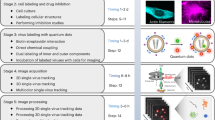Abstract
To analyze the intracellular movements of subviral particles (nucleocapsids, NCs) of the Marburg virus, the viral protein VP30 has been labeled fluorescently. This makes the NCs observable by fluorescence microscopy under biosafety level 4 conditions. An algorithm has been developed, aiming to allow the automated detection and tracking of the NCs . The specific feature of this approach is the inclusion of expertise about the NCs’ appearance and movement characteristics, what gives more reliable results than a simple nearest neighbor linking of the detected NCs.
Access this chapter
Tax calculation will be finalised at checkout
Purchases are for personal use only
Preview
Unable to display preview. Download preview PDF.
Similar content being viewed by others
References
Schudt G, Kolesnikova L, Dolnik O, et al. Live-cell imaging of Marburg virusinfected cells uncovers actin-dependent transport of nucleocapsids over long distances. Proc Natl Acad Sci. 2013;110(35):14402–7.
Smal I, Draegestein K, Galjart N, et al. Particle filtering for multiple object tracking in dynamic fluorescence microscopy images: application to microtubule growth analysis. IEEE Trans Med Imaging. 2008;27(6):789–804.
Meijering E, Dzyubachyk O, Smal I. Methods for cell and particle tracking. Methods Enzymol. 2012;504:183–200.
Cheezum MK, Walker WF, Guilford WH. Quantitative comparison of algorithms for tracking single fluorescent particles. Biophys J. 2001;81(4):2378–88.
Meijering E. Cell segmentation: 50 years down the road [life sciences]. IEEE Signal Process Mag. 2012;29(5):140–5.
Arulampalam MS, Maskell S, Gordon N, et al. A tutorial on particle filters for online nonlinear/non-Gaussian Bayesian tracking. IEEE Trans Signal Process. 2002;50(2):174–88.
Godinez WJ, Lampe M, W¨orz S, et al. Deterministic and probabilistic approaches for tracking virus particles in time-lapse fluorescence microscopy image sequences. Med Image Anal. 2009;13(2):325–42.
Kienzle C, Schudt G, Becker S, et al. Subviral particle tracking. Biomed Eng/ Biomed Tech. 2013;58(s1-keynote):1–4.
Fawcett T. An introduction to ROC analysis. Pattern Recognit Lett. 2006;27(8):861–74.
Author information
Authors and Affiliations
Corresponding author
Editor information
Editors and Affiliations
Rights and permissions
Copyright information
© 2014 Springer-Verlag Berlin Heidelberg
About this chapter
Cite this chapter
Kienzle, C., Schudt, G., Becker, S., Schanze, T. (2014). Multiple Subviral Particle in Fluorecsence Microscopy Sequences. In: Deserno, T., Handels, H., Meinzer, HP., Tolxdorff, T. (eds) Bildverarbeitung für die Medizin 2014. Informatik aktuell. Springer, Berlin, Heidelberg. https://doi.org/10.1007/978-3-642-54111-7_61
Download citation
DOI: https://doi.org/10.1007/978-3-642-54111-7_61
Published:
Publisher Name: Springer, Berlin, Heidelberg
Print ISBN: 978-3-642-54110-0
Online ISBN: 978-3-642-54111-7
eBook Packages: Computer Science and Engineering (German Language)




